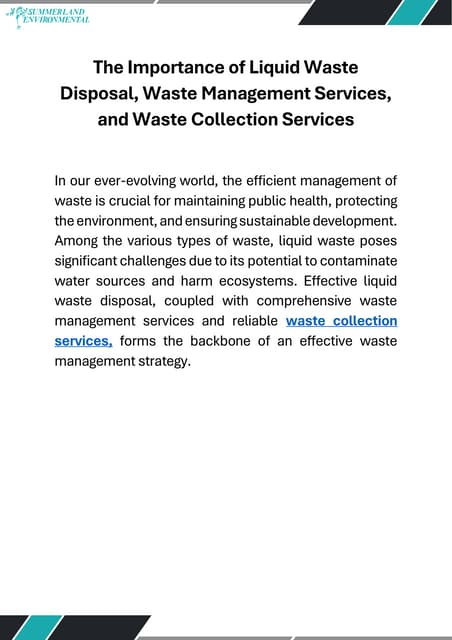The Basic Principles Of Reclaim Waste
The Single Strategy To Use For Reclaim Waste
Table of ContentsThe 6-Minute Rule for Reclaim WasteReclaim Waste Things To Know Before You BuyExamine This Report about Reclaim WasteFascination About Reclaim WasteExcitement About Reclaim Waste
Discover the types, events, and types of liquid waste. Domestic sewage waste describes the waste and items from a household septic system. This type of waste is created by human beings in residences, institutions, and other structures. This only consists of septic systems that have a drain area. The proper management and disposal of residential sewage waste require fluid waste to be transferred to a sewage therapy plant where the appropriate approaches and tools are applied to purify and get rid of waste.
Commercial waste frequently consists of prospective risks, such as combustible materials or a mixture of liquid and solid waste products, and calls for an advanced and in-depth disposal procedure. The disposal of commercial waste commonly involves the filtration of waste before transportation to ensure risk-free and appropriate disposal. Hazardous waste is created from by-products and runoff of industrial processes and manufacturing.
This kind of waste can not utilize the exact same sewer monitoring transportation or processes as septic or commercial fluids. The hazardous waste monitoring process calls for the inspection and screening of liquid waste before it undertakes the disposal procedure (liquid waste removal). Runoff waste is the fluid waste that originates from overflow and excess stormwater in extremely populated areas or cities
Runoff waste can trigger contamination and flooding otherwise handled appropriately. Learn much more concerning drain cleansing and waste administration. Guaranteeing correct waste administration can prevent catastrophes and lower ecological harm. Both people in property settings and experts in industrial or production industries can take advantage of understanding the processes and policies of fluid waste management.
7 Easy Facts About Reclaim Waste Shown
Contact PROS Solutions today to find out about our waste administration and disposal services and the proper ways to look after the liquid waste you create.
(https://www.anyflip.com/homepage/imqzz#About)Do you know what takes place to your water when you end, flush the commode or drain pipes the cleaning machine? No? Well, it deserves understanding. This supposed 'wastewater' is not just an important source yet, after treatment, will be launched to our land, rivers or the ocean. Made use of water from commodes, showers, baths, kitchen sinks, laundries and industrial procedures is referred to as wastewater.

water made use of to cool machinery or clean plant and tools). Stormwater, a kind of wastewater, is drainage that moves from farming and urban areas such as roof coverings, parks, yards, roads, paths and rain gutters right into stormwater drains pipes, after rain. Stormwater streams neglected straight to neighborhood creeks or rivers, ultimately reaching the sea.
The 3-Minute Rule for Reclaim Waste
In Queensland, most wastewater is dealt with at sewage treatment plants. Wastewater is moved from residential or commercial sites with a system of sewers and pump stations, referred to as sewerage reticulation, to a sewer treatment plant. Regional governments construct, preserve and run most sewage treatment plants. Operators are certified under the Environmental Management Act 1994 to release treated wastewater at an appropriate environmental requirement into waterways.
The Department of Natural Resources encourages regional governments about managing, operating and maintaining sewerage systems and therapy plants. In unsewered locations, city governments might call for homeowners to set up specific or family sewage treatment systems to deal with residential wastewater from bathrooms, cooking areas, shower rooms and washings. The Division of Natural Resources authorizes the use of home systems when they are confirmed to be reliable.
In some new communities, treatment of some stormwater to get rid of litter, sand and gravel has started making use of gross pollutant traps. Wastewater treatment happens in four stages: Eliminates solid matter.
Wastewater after that flows right into big storage tanks where solids clear up and are gotten rid of as sludge. Grease and residue are skimmed from the surface. Uses tiny living microorganisms referred to as micro-organisms to damage down and get rid of continuing to be dissolved wastes and great fragments. Micro-organisms and wastes are included in the sludge. Gets rid of nitrogen and phosphorus nutrients that could trigger algal blossoms in our rivers and endanger marine life.
Facts About Reclaim Waste Revealed
Nutrient removal is not readily available in all sewer therapy plants due to the fact that it requires great site expensive specialised equipment. It is ending up being a lot more typical in Queensland. Clear fluid effluent generated after therapy might still have disease-causing micro-organisms. If this effluent is released right into rivers such as rivers or the sea, the micro-organisms will at some point pass away out.

This typically indicates wastewater has to be treated or impurities removed before it can be discharged to waterways. The majority of wastewater streams right into the sewage system. Under the Act, neighborhood federal governments provide approvals and licences for environmentally pertinent tasks (Ages) involving wastewater launches that could have a neighborhood effect. The department carries out approvals and permits to Ages involving wastewater launches that may have a regional or statewide influence.
The Buzz on Reclaim Waste
Surveillance provides factual details concerning water top quality and can confirm that licence problems are being fulfilled. The information gotten with tracking offers the basis for making water high quality choices.